18th November, 2013
From Raymond Goh:
Today, the tomb keepers helped to clear the thick vegetation around a cluster of old graves in Hill/Blk 2, believed to be relocated from Tiong Bahru in the late 1920s due to development, thereby revealing more tombs previously hidden among thick vegetation. Some of these old graves are affected, while some are not due to the angle of the road project which slices this cluster into half. One pioneering immigrant, that of the mother of Chee Yam Chuan has been found in this cluster. We believe other pioneers could be uncovered soon.
Read about how Raymond identified Madam Chee Kim Guan here
Seeing the cleared tombs for the first time inspired Claire Leow to pen these lines for these pioneers, who arrived about the time of Sir Stamford Raffles, making them the earliest immigrants of recent history.
The Sentinels of Bukit Brown
We stand
Sentinels of Bukit Brown
Watched this land we called Sin-chew (星 洲) from afar
Put down roots, rebuilt our lives,
Cajoled our families to join us.
We, the sinkehs, arrived.
Farewells aplenty in our lifetimes
To family, to China.
Here in our new home, to our former burial grounds which looked after us,
As we made way for our descendants, and for more sinkehs.
Goodbye Tiong Bahru, hello Bukit Brown.
Years have passed. Like a gentle breath. Like the wind.
Bombs came, new inventions we did not yet know.
Shouts of languages we did not fully understand.
In death, others whispered to us that which we did not witness
The Japanese came with shouts of Banzai! The British scrambling in the undergrowth to hide amongst us.
Then peace and quiet again.
Roots grew around us, sheltered us.
And we hosted the birds and monkeys and spied an occasional dog. Hid a few snakes in our time.
We enjoyed the distant voices of children at play.
We, the sentinels of Bukit Brown.
And now,
Time for more farewells.
Our friends and neighbours in death,
Long have we stood together.
Decades have come and gone and among many farewells, we never expected the dead would be parted.
Not like this.
Ong, I see you over there. Chew, you look bright and clean with the grass trimmed. Lim, I never knew you had that many children!
So many years, and now, not enough time!
We don’t have time left to get to know each other better.
We thought we had eternity…
We thought we were the sentinels of Bukit Brown.
All we had was time.
Come, let us not tarry.
Lets get to know each other better.
Before our final farewell.
We who know how to depart and how to find new homes, come.
Footnote:
“Sin Chew” is a sobriquet for “Singapore” popularized by Nanyang literatus Khoo Seok Wan (also buried at Bukit Brown and to be exhumed for the highway). Singapore is an island surrounded by the sea, and with vessels and boats large and small anchored around it; the glitter of artificial lights at night are like a crown of illuminated stars (“星”) when viewed from afar. “洲” (zhou, island) and “舟” (zhou, boat) are homonyms: while the boat lights are like stars, those on the island are like the Big Dipper to accentuate the constellation. This is why the term “Sin Chew” is widely known by folks here and afar.
(Liang Shao Wen, “Nanyang Travels”, p. 62, circa 1920s, translated by Lai Chee Kien)
Related posts:
A Brief History: Walk of Fame, Darkly
The Case for a Bukit Brown (National) Heritage Park
by Chew Kheng Chuan
7 November, 2013.
Sometime ago when I was looking at Google Earth to check out Bukit Brown, I was struck by what a huge green lung it was that was contiguous to the main Water Catchment Area of MacRitchie and Pierce Reservoirs. In that sense the greenery was part of a single “critical mass,” whose significance – ecological and environmental – depended critically on its mass to create the climatic and rainfall needs of Singapore. I felt that taking away this greenery would be a major detraction and subtraction that cannot be replaced by the addition of many other smaller parcels that may add up to the same area if aggregated.
Otherwise I am very sympathetic to the pressures of the planners needing to look to the provision of housing and road requirements of a developing city and nation.
However I feel it is highly regrettable that Bukit Brown Cemetery has to be sacrificed on the altar of development. It will be an irretrievable loss. This is a resting place of the pioneers of our nation and is a cultural and historical heritage that is the physical expression of our sense of origins and identity.
Are there alternatives? This is a serious question that must be considered further and deeper. When Bukit Brown is developed into a future residential estate, the beneficiaries are limited to the fortunate people who will live there, next to the greenery of MacRitchie Reservoir. However it will be lost to the larger public.
Yet if Bukit Brown were to be gazetted as a National Heritage Cemetery Park, and developed as such, keeping all the graves which represent the earliest of burials in Singapore, and are an authentic expression of the anthropological rituals, ceremonies and culture of a people (still alive and active annually every Cheng Beng period), it can benefit all residents of Singapore, and into the future. Let me explain why.
Indeed the National Parks Board can look to developing this into a National Heritage Cemetery Park (or should that be the Bukit Brown Heritage Cemetery National Park?), develop the landscape and plantings, preserving the old trees, and grow new flora. Then it becomes a NEW environmental, recreational, cultural, historical, educational, natural, and yes, economical-tourism resource for all residents in Singapore – citizens, PRs, migrant workers, visitors, tourists, students, nature lovers, birdwatchers, filial descendents who observe the rites and rituals of Cheng Beng
It then becomes a public space rather than a private, historical, forgotten, “under-utilised” cemetery. Perhaps a stronger case can be made that this serves more powerfully the larger public good than the limited number of the lucky few future residents of the new residential estate of Bukit Brown?
An MRT has been planned and will be built for Bukit Brown – indeed, that will not detract from nor be wasted by the new identity and purpose of this National Heritage Park, for all of Singapore will need good transportation access to it to enjoy its benefits. The Bukit Brown MRT in a new status of Bukit Brown will in the longer run better justify its location and existence, bringing a far greater number of commuters to it than that planned for just residents of the area were it to be an exclusive residential district.
I would argue for considering such an alternative future for Bukit Brown to preserve its past of pioneer burials, and enhance its future, even if my ancestors were not buried there. Indeed, as a child I used to accompany my father and relatives every Cheng Beng, but with their passing I have discontinued this ritual for many decades, which explains why my children have never visited the grave of their great-great-grandfather Chew Boon Lay until recently
I asked my children what thoughts they might wish to share. They said:
“Our father told us we are 5th generation Singaporeans, which we think is cool. We wonder how many of our friends have been in Singapore for 5 generations? Our great great grandfather Chew Boon Lay and great grandfather Chew Hock Seng, are both buried at Bukit Brown. We’re kinda sad that when the cemetery is gone they will be just a memory and lost in our future.”
Chew Kheng Chuan is the great grandson of Chew Boon Lay.
Tripadvisor Travellers’ Choice® 2013 Winner “Ranked #16 of 665 attractions in Singapore. “
6 November, 2013.
Latest Reviews
“Get there before its too late…This is a very special place – peaceful, beautiful, historic, and a natural wildlife haven”
Visit Bukit Brown cemetery while you still can – before the bulldozers move in to create yet another expressway. This is a very special place – peaceful, beautiful, historic, and a natural wildlife haven. Intricately carved statues guard many of the old gravestones, which are often adorned with gorgeous antique tiles painted with flowers and peacocks. There are several pathways to explore and so the cemetery also makes a lovely place just to visit for a ‘country’ walk. Kingfishers, monitor lizards, monkeys and nightjars are common sights, and some of the huge banyan trees are staggering. In recent months the ‘Friends of Bukit Brown’ have painstakingly signed and cleared pathways to the gravestones of many notable names from Singapore’s history, making this an even more interesting place to visit.
Visited October 2013
HilarySingapore
Singapore is a concrete jungle and if there is a garden, it is man-made, like Gardens by the Bay…..(except for) a historical site called Bukit Brown.
Today, I had the privilege of touring a historical site called Bukit Brown. Bukit Brown is a cemetery, where many of Singapore’s pioneer are buried and may soon be “awakened” from their peaceful slumber to make way for 8 lanes highway.
I toured with volunteers of Bukit Brown, and learn about the tombs of Tan Kheam Hock and his family. History is being collected as I write this review. The tour is made even more interesting with the descendants of Tan Kheam Hock in our midst. A definitely worthy visit for any tourist to Singapore, to see a side of Singapore which money cannot buy.
As Bukit Brown tour is manned by volunteers with a passion to preserve the heritage and culture of this little city state, one will need to visit Bukit Brown FB page to make enquiries of any tours.
Visited October 2013
IreneLim63
It was like stepping back into another place and time. You can see rays of sunshine illuminating the misty verdant hills, rich smell of the forest and hear sounds of delightful birds. It was somewhat surreal in heavily urbanised city but the oasis of tranquility calms the soul and the mind is clarified. What a wonderful place to go for a walk!
I joined a friend to witness the Cheng Beng festivity and was overwhelmed by the throngs of people with their prayer paraphernalia and the heavy traffic winds patiently through the hills. It was BUSY!
Then some 3 months later, I took a trip with the Brownies who gave free guided walks through Bukit Brown practically every weekends! It was like stepping back into another place and time. You can see rays of sunshine illuminating the misty verdant hills, rich smell of the forest and hear sounds of delightful birds. It was somewhat surreal in heavily urbanised city but the oasis of tranquility calms the soul and the mind is clarified. What a wonderful place to go for a walk!
Yes, we have the crowded Botanic Gardens, the monotonous MacRitchie & Pierce reservoirs, the hot Sungei Buloh Reserve and Chek Jawa Park is a little too far to reach but Bt Brown is way too cool! If you dare venture off the main track, you will encounter unusual structure, designs, engravings, statutes, reflecting the various cultures, beliefs & eras. You might encounter a monitor lizard, horse riders and almost always expats walking their dogs. Join the Sats & Suns groups of 10-20 people on the guided walks like the one I’ve taken, listening to the passionate guides who are bursting to share with you the stories of the hills.
Visited September 2013
Ally A
“The most beautiful place on earth”
Jo Prudence, descendant of George Henry Brown, after whom the cemetery is named.
A spectacular time-lapse aerial video of Bukit Brown
More beauty shots of Bukit Brown here
Han Yi Jie 寒衣节
By Victor Yue
4 November, 2013
Han Yi Jie, which means “warm clothing event”, is a Chinese tradition when the start of winter reminds the people that their ancestors and departed loved ones would also be experiencing the cold. And so, they make offerings of food and warm clothing for them.
In Singapore, where it is always warm (hot in fact), such a tradition hardly exists. But, Xuan Jiang Dian 玄江殿, a Chinese temple dedicated to Xuan Tian Shang Di (玄天上帝), known as God of the North, continues with this tradition. For a a long time now, every year without fail, on the first day of the tenth lunar month (moon), this temple, with its devotees would visit Bukit Brown Cemetery to make offerings to the wandering souls. To the Chinese, the first day of the 10th moon marks the beginning of Winter. (Wandering souls are souls of the departed who do not have anyone (descendants) making offerings to them)
This year the first day of the 10 lunar month, fell on 3 November. As has been their tradition, members of Xuan Jiang Dian 玄江殿 went to Bukit Brown Cemetery to make offerings to the wandering residents of the cemetery. This year saw a bigger offering. Could there have been an increase in the number of wandering souls? Devotees of the temple contributed warm clothings, money (in the form of joss papers) and food. Some Brownies also contributed towards the offering of the warm clothings (in the form of paper robes).
This year, Shan Cai Tong Zi 善才童子, through a spirit medium, came along to offer sermon (dharma) to the invited souls at the gathering by the Ole Rain Tree. Shan Cai Tong Zi is a deity who is one of the 500 assistants to Guan Yin.. In S.E,Asia, he is a popular deity who is trance by spirit mediums. He is only 3 years old and the older folks, especially old aunties, like him, because they can be less formal, unlike the warrior deities.
Shan Cai Tong Zi, through his ancient Hokkien and mudras offered blessings to the gathered souls. Offerings which ranged from various kinds of kueh kueh, joss sticks, coins to rice were made.
Offerings which ranged from various kinds of kueh kueh, joss sticks, coins to rice were made.
Before the start of this event, respects were also accorded to the guardians of the hills.
After the blessings and offerings to the wandering souls, it was time to bless the living souls who gathered to contribute towards this event. Good health and good luck were amongst them being blessed onto the members gathered. Members were offered the five different beans (known as Gor Tao 五豆 in Hokkien) to bring back home. A big “Huat Kueh” (a traditional Hokkien cake made with yeast and flour through steaming) that was made in the temple by members for this event was offered to all present to take bit to eat, for good luck and “jia peng an” (吃平安) meaning eating to get the peace”)。
With the impending construction of the 8 lane highway through Bukit Brown, this is likely the last time that Han Yi Jie will be conducted at the ‘ole rain tree. But we still hope it will not be the last at Bukit Brown.

Lighting the way by the barricades erected in preparation of the start of exhumation (photo Andrew Lim)
Globalising the Local
( a forum organised by the Singapore Heritage Society)
4 November 2013
In December 2012 the historic Singapore Botanic Gardens became a nominee for UNESCO World Heritage site status. In October 2013 Bukit Brown was selected by the World Monuments Fund to be included in the 2014 World Monuments Watch list. Two equally deserving heritage sites on different pathways towards international recognition. What does it mean to be recognised as a World Heritage site or to be on the World Monuments Watch list? Are these new ways of thinking about the significance of heritage in Singapore? Can heritage give us insights into what being global means for Singapore and Singaporeans?
Join us at the Forum where we will hear expert speakers explain the meaning and significance of these developments.
Please register early as seats are limited:
https://
10 November 2013, 2-4pm
Ngee Ann Auditorium, Asian Civilisations Museum
Moderator
Dr Chua Ai Lin – President of the Singapore Heritage Society
Speakers
Dr Kevin YL Tan – President, ICOMOS Singapore
Dr Ian Chong – Political Scientist
Ms Faizah Jamal – Nominated Member of Parliament
Dr Lai Chee Kien – Architect
Kwong Tong Cemetery Kuala Lumpur
by Simone Lee
4 November, 2013
The Kwong Tong Cemetery is the oldest cemetery in Kuala Lumpur, covering 343 acres of land. It is the final resting place of many prominent city pioneers including Yap Ah Loy, the founder of Kuala Lumpur. In 2007, the 112-year-old cemetery – a green lung in the city – was named a Heritage Park.
My great grandparents are buried in Kwong Tong Cemetery and in October this year I visited them for the second time in 20 years. I can barely remember my first visit as a child. The visit was a result of a confluence of events, the catalyst : Bukit Brown. I first visited Bukit Brown in July, a week after the death of my father. In the weeks that followed I joined the Brownies regularly on their guided walks. I was moved by the stories they told of the pioneers buried there and their contributions. On October 5th, after I conducted my first guided walk “Stories of Ladies in the Straits Settlements”, I felt I was ready to trace the path of my roots.
Even as I embarked on the journey , I was helped by a fellow Brownie, Jonathan Siew who introduced me to his friend Boon Hin who knew Kwong Tong Cemetery well. He drove my mother and I around the cemetery. Naturally, our first stop was at my great grandparents’ tomb .
My Great grandparents Graves
Just like many other sinkehs (new comers, fresh from the boat from China) at that time, my great grandfather, 利曉春(1888-1962) and his wife arrived from Meixian, Guangdong in the 1930’s. He was a tailor but soon went into tin mining, a thriving commodity in Kuala Lumpur at that time. He was successful and brought my grandfather over to help him in the tin-mining business. The entire family (3 generations; great grandparents, grandparents’ siblings and their children) lived in a large British colonial villa at Bukit Bintang (which was later torn down to build shopping malls).
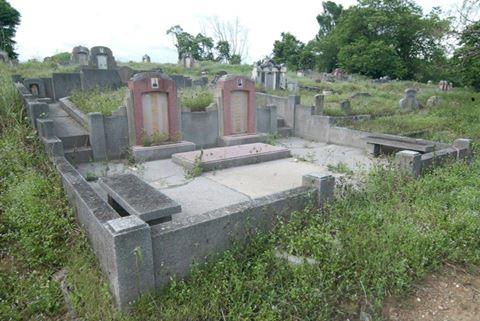
Kwang Tong: The graves of 利曉春(1888-1962) and his wife, Simone’s great grandparents (photo Simone Lee)
Mah Kan Poh
My great grandparent’s neighbour is Mah Kan Poh
The epitaph on the late Mah Kan Poh’s tombstone erected by his descendants.
“Born on the 14th day of the 12th Moon of Thung Chee Yam Shutt Year, or the 1st of February 1863; and Died on the 29th of May, 1938, or the 1st of 5th Moon, Mo Yen Year – at the age of 77 years. The late Mr.Mah Kan Poh was a native of Yong Kow village, Soon Tuck District – in the province of Canton. He was very thrifty and hardworking, and took to silk trading as his first walk of life. At the age of 26 years, he came over to Malaya. He was first interested in tin-mining and then – revenue farms. Later on he took to rubber planting and he could walk for miles daily in his estate and mines. One of his favourite hobbies was hunting. On many occasions, we advised him to give this up, but he turned a deaf ear to our counsel. In summing up, we might say that the deceased was a man of great courage and determination, and that we and our descendants should follow his footsteps as best we could.”
The Nanyang Volunteers Memorial erected in 1947
When the Sino Japanese War erupted on 7 July 1937, the Chinese government’s logistic concern was security of supply routes importing war materials into China. This led to the construction of the Burma Road linking Kunming with Yangon port in British Burma. The Chinese government also realized the lack of skilled drivers and mechanics in China. To solve this problem, they turned to China Relief Fund headed by Mr Tan Kah Kee to recruit drivers and mechanics from all over Nanyang, today’s South East Asia. These drivers and mechanics are known as the Nanyang Volunteers, 南侨机工. From February to September 1939, 3200 Nanyang Volunteers left in 15 batches and most eventually served on the Burma Road. Most of the Nanyang Volunteers were Chinese man but there were also some Malay and Indian men and four Chinese women. Source
The Japanese War Memorial
This site marks a 10,000 square feet mass grave of the casualties during the Japanese occupation. Remains of close to a thousand victims were relocated from the original site, “Tomb of War Victims of the Compatriots of the Republic of China” which was in a dilapidated state.
The Butcher’s Guild Graves
Built in 1931, from the back, it’s a walk through concrete grids towards the front yard.

Kwong Tong:concrete grids of the graves of the Butcher’s Guild, view from the back (photo Simone Lee)
The Lim Lian Geok Memorial
Lim Lian Geok (1901-1985) was former Chairman of The United Chinese School Teachers’ Association Of Malaysia (popularly known as Jiao Zong), was a great educationalist as well as a famous social activist.
People from all over the country, put aside their works and came all the way to pay their last respects to him, including high-ranking leaders of political parties. A fund in memory of him was set up, which was later registered as LLG Cultural Development Centre, a non-profit organization. Source
Chua Cheng Tuan : The Cycle & Carriage Family
The Cycle & Carriage family: All except for the 2 tombs at extreme left and right (forefront) are in the Chua family gated plot. You can even see the fence surrounding the cluster behind the trees on the left of photo. At the centre of the plot is Mr.Chua Cheng Tuan, the founder of Cycle & Carriage. His brother Chua Cheng Hock is buried in Bukit Brown.
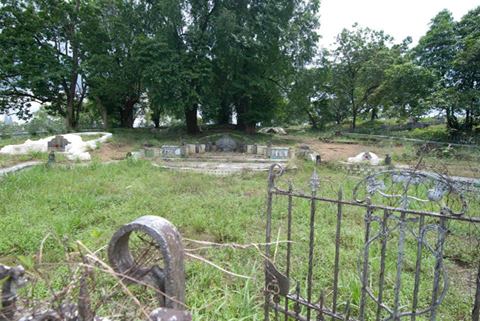
Kwong Tong : centre of the family cluster is plot of Mr.Chua Cheng Tuan, the founder of Cycle & Carriage (photo Simone Lee)
A pavilion was built by Chua Cheng Tuan’s family, in front of the family plot, in his memory. Today many other graves surround the pavilion.
Other interesting tombs at Kwong Tong Cemetery
This collective teochew tomb has a large mound and a tortoise supporting the tomb stone. Engravings of the Confucian story; 24 filial exemplars lines the arms of this large tomb.

Kwong Tong:panels with stories of the 24 filial piety exemplars on the “arms” on the Teochew tomb (photo Simone Lee)
The Hindu Day of Remembrance
by Sugen Ramiah
1 November 2013
Like the Chinese who observe the annual “qing ming” or tomb sweeping festival in April, the Indians also honour their ancestors with a visit to their ancestors tombs on the Hindu day of remembrance. It takes place the Sunday before Deepavali, the festival of lights which falls on 2nd of November, Saturday.
On Sunday 27th November, I visited the Hindu cemetery located in Lim Chu Kang to pay respects and place offerings on my ancestors’ tombs.
My grandparents to date have a total of 125 descendants but sadly only 4 turned up, two cousins, my brother and myself.
The trip usually lasts for about two hours, as we’ll clean up five tombs, four in the Hindu Cluster and one in the Catholic cluster. Simple offerings including fruits and sweetmeats were placed on a banana leaf. With the lighting of an oil lamp and incense, the Indians remember their dearly departed.
In the evening at home, the entire family would gather. A feast that consists of eight dishes – chicken, mutton, eggs, fish, prawns, squid, crabs and vegetable, together with fruits, sweetmeats and Indian Peranakan delicacies such as the “kueh wajek”, will be laid before portraits of the ancestors. New cloths would be placed beneath the portrait, incense lit and finally the family members would eat the food that were offered.
Traditionally our forefathers from India were cremated , so there was never a need for tomb stones like the Chinese, Muslims and the Christians. The deceased were usually cremated within the day of death. But if they were wealthy, they would be given a burial. In the Hindu custom, the dead is also remembered on their death anniversary, known as a “theethi’”where a “mocham” lamp (light of liberation) is lit as a sign of remembrance.
Hindus have more than one festival to remember and honour their ancestors. On the full moon of the sixth lunar month of ‘Puratasi’ which falls in September/October, there is the ‘Mahalaya Amavasay’ also known as the fortnight of the ancestors. Hindus pay homage to their ancestors and offer prayers for the repose of their dearly departed at temples.
Some Hindus commemorate the dead during the Matu Pongal, on the second day of the “Pongol” Harvest Festival. The Indian Peranakans, known as the Chitty, celebrate the eve of Pongal with Bhogi Parachu – the ancestral worship festival. Since there were a few festivals to remember the dead, the local community here and in Malaysia decided that the Sunday before Deepavali will be the day of remembrance.
My grandfather, a wealthy merchant born in 1884, came to Singapore and contributed greatly to the Indian community of Singapore in the 1900s. He started the first dairy business here and contributed to the Sri Mariaman Temple in South Bridge Road He married my grandmother who was a Chitty- Indian Peranakan – from Melaka(Malacca) and she was the matriarch of the family. The honorary title is currently held by my aunt who is 85 this year.
As a Brownie, I have been moved by the descendants who return every year to Bukit Brown during “qing ming” to clean the tombs and pay their respects. I am also sadden by the tombs that lay neglected, which have been forgotten, and I hope more descendants will come forward and reconnect with their ancestors.
I am blessed and grateful to the friends/volunteers of Bukit Brown, who have kindly showed me how to appreciate and understand my own heritage and to be proud of who I am. This was the first time, my brother marked the remembrance day for our grandparents and it was for him an eye opening and moving experience.

Grandfather’s tombstone at the Hindu Cemetery, simple offerings of fruits, sweetmeats and roti prata were offered on top of a banana leaf (photo Sugen Ramiah)
Sugen Ramiah is a teacher by training and his interest includes observing and documenting Chinese festivals and rituals conducted by temples.
Read his blog posts on Salvation for Lost Souls here and here
All Things Bukit Brown broke the news that Bukit Brown had been included on the list of the World Monuments Watch 2014, on the evening of Tuesday 8th October, 2013. It was the first listing for Singapore, and international recognition of Bukit Brown as a heritage site.
24 hours later, on Thursday 10th October, 10 am, a media session to meet the Brownies behind the submission to the World Monuments Fund, was held at Bukit Brown, under the rain tree at the roundabout. It was an appropriate setting, as this is the spot where all our guided walks begin.
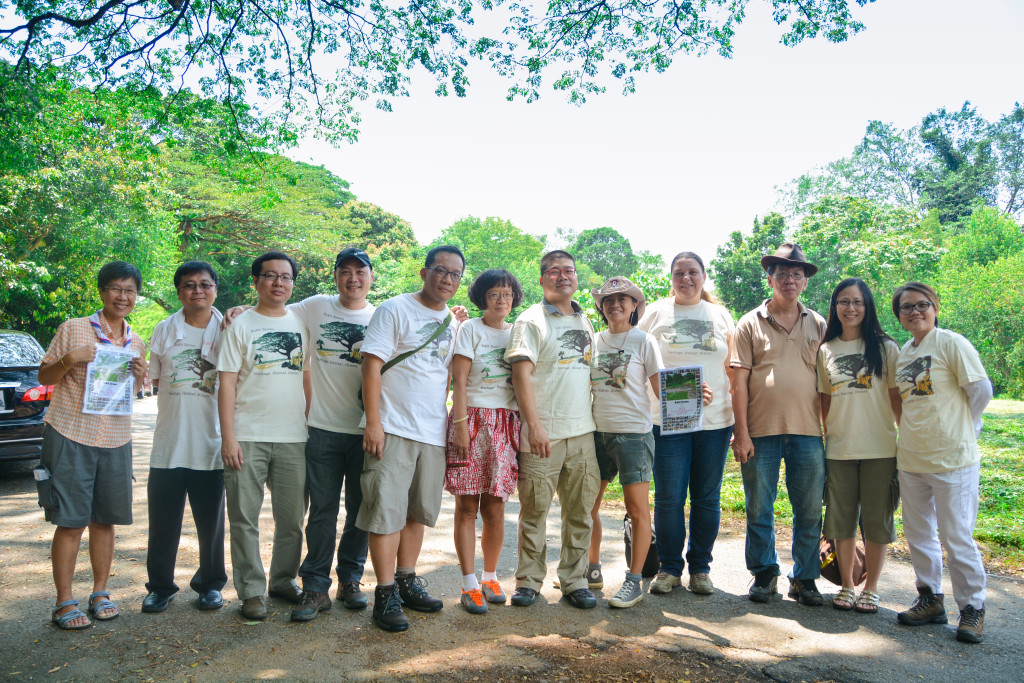
Supporters and the Brownies behind the submission for World Monuments Watch 2014 listing (photo Terry Xu)
Full video recording by Jasmine Ng here
This is a compilation of highlights and quotes of the media coverage online, in the press and in the broadcast media from 9 October to 13 October, 2013
10 October Channel News Asia TV report on Bukit Brown’s World Monuments Watch listing.
Interest group hopes that this(the listing) will lead to more engagement and a more sustainable strategy for development. Claire Leow “We hope this listing by shining international attention on Singapore will also help Singapore’s bid to get UNESCO listing for Botanic Gardens and of course eventually Bukit Brown as well and eventually other sites as well in Singapore”
The full CNA TV report here
Claire Leow, co-founder of All Things Bukit Brown, said: “It goes beyond what we’ve done for Bukit Brown; it’s more like what we can do for Singapore.
She added: “I hope it shows that we are serious, that we want a seat at the table, just so we can present what we have heard from the community, what we have heard from the people who have encouraged us, and we can share their voices too.
The full online CNA report here.
10 October Zaobao
“I hope to use this opportunity open a dialogue with the government and find a sustainable path to development. I do not think that conservation of heritage monuments and development has to be confrontational. On the contrary, we hope that conservation can aid development and vice-versa“
She pointed out that at present, talks about development and conservation are always framed in terms of trade-offs – e.g. do we want to keep land for our ancestors or make room for our descendants. Why do we not talk about other issues, e.g. are we not willing to let go of a site that could potentially be a world heritage site? In the face of global warming and the need for nature to maintain stable temperatures, can we afford to lose a site of certain environmental value to us? Claire Leow.
The full Zaobao report with translation here
10 October The Online Citizen (TOC)
“There’s more to Bukit Brown, than my own family. And I realised the things I do not know about this place and it’s going to go. And that nothing will be left for my children, grandchildren and great grand children. ” Ong Hui Lin (descendant with 3 ancestors buried in Bukit Brown)
“Yes Bukit Brown is now on the World Monument Watch but it is more than that. We nominated Bukit Brown because it is significant to our history, culture and society. I hope that this will prompt people to look into all 3 aspects.” Claire Leow
The full video report on TOC here
10 October Razor TV online
“Now with the listing, it gives credence to the fact that this is a world class heritage site. So my sense is that one has to think again about the questions,, I appreciate the challenges that urban planners face. But maybe they don’t have a larger picture and that larger picture is history and heritage, history that affects out identity” Chew Kheng Chuan (descendant with 8 ancestors buried in Bukit Brown”
“I am very mixed because I am a road user and I love homes. Homes for my children. But for Bukit Brown, it is very painful because when we lose it, we would never get back the very essence. the soul” Ong Hui Lin (descendant with 3 ancestors buried in Bukit Brown)
The full online video of Razor TV here
10 October the breakfast network
“They (All Things Bukit Brown) hope more researchers, historians, cultural studies students et cetera would step up and get involved in Bukit Brown in one way or another. “We need to think differently; we need to reframe the conversation,” said Ms Leow, who wanted people to stop seeing the trade-off as space for the living vs space for the dead. Rather, she wants to foreground Bukit Brown as a potential world monument site, with environmental value, that is at stake.
The full report of the breakfast network available here.
All Things Bukit Brown clarifies on the report : We did not submit the application for World Monuments Watch listing to “throw a spanner in the roadworks”. We submitted it because we wanted recognition, to heighten awareness and draw attention to Bukit Brown as a heritage and nature site worthy of preserving.
10 October (The Economist) Banyan Blog
“In an interview republished in his latest book, Lee Kuan Yew, Singapore’s elder statesman, who left the cabinet two years ago but still reflects the views of many in the government he led for so long, is, characteristically, yet more blunt in an interview reprinted in his latest book: “if we need the land, and we have to dig up the whole of Bukit Brown to build on it, and put the ashes in a columbarium, we will do it.”
The Brownies point out that the government presents a false choice between space for the dead and space for the expanding population that Singapore needs to sustain its growth. Bukit Brown is also for the living, and for future generations interested in how Singapore became what it is today.”
The full report on the Banyan here
10 October : Singapore Heritage Society statement on the listing:
This is the first time a Singapore site has been included in the World Monuments Watch. Together with the Singapore Botanic Gardens’ UNESCO nomination, Bukit Brown’s inclusion represents widespread international recognition of the historical importance of local heritage sites. Indeed, Bukit Brown’s narrative of early immigrants and regional histories complements the Botanic Garden’s narrative of colonial empire to provide a more complex and complete story of Singapore.
13 October Yahoo News
“With the World Monuments Watch listing, the first time a site in Singapore has been included, atBB thinks that Bukit Brown and the Gardens, which are located fairly close to each other, could be paired up for a stronger nomination, said (Catherine) Lim.
“What we’re saying is there’s an opportunity here to relook our application (to UNESCO),” she said. “It has started, but it’s going to take two years (to complete), so why not explore? We’re offering up an opportunity of a possibility… It’s for the government to consider this. I’m not sure whether they actually have considered the actual status that’s accorded Bukit Brown being on the list.”
The full report on Yahoo News here
A Question of Public Value : Bukit Brown . a thought essay by Z’ming Cik was submitted for the “My Say” category of the blog on 13th October.
9 October 2013 Straits Time (ST) Report
SINGAPORE’S Bukit Brown Cemetery has been named as an at risk site on the 2014 World Monuments Watch – a biennial listing by the World Monuments Fund which compiles cultural heritage sites that are threatened around the world.
Bukit Brown Cemetery, where the graves of pioneering Chinese immigrants to Singapore since the mid-nineteenth century stand, is one of 67 sites from 41 countries and territories.
More on the ST report here
9th October Channel News Asia (CNA) Report
SINGAPORE: Singapore’s Bukit Brown Cemetery has been placed on the 2014 World Monuments Watch, which compiles cultural heritage sites threatened around the world.
More CNA report here
All Things Bukit Brown clarifies on the report below by ST News October 10, 2013 : When asked by the reporter about the call for a moratorium to stop road works issued in March 2012, the a.t.bb’s response was “we have moved on from that” as opposed to what was reported ” the group, which hosts weekly guided tours at the site, is also sticking to a call it made last year for a moratorium on plans for Bukit Brown and for more public engagement with the Government.”
ST News Oct 10, 2013
All Things Bukit Brown, an interest group which is keen to preserve the site’s heritage and habitat, nominated it to the New York-based World Monuments Fund watch list. It was picked from 248 nominations – making it the first time that a Singapore site has made it to the list. The WMW citation said of the road and redevelopment of the site: “In destroying the cultural landscape of Bukit Brown, it is a loss to all of society.”
The non-profit World Monuments Fund has issued its watch list since the 1990s to raise awareness about threatened cultural sites. It has helped to helped restore sites in more than 90 countries, including the historic enclave of Georgetown in Penang .
The full ST report here
From The Diplomat on 30 October 2013
Abstract : “We must be reminded that there are other land uses that take up enormous amounts of space, yet hardly anyone is questioning the utility of those spaces. Singapore has 18 golf courses, one of the highest numbers per country area in the world. They take up a total of 1,800 hectares. By contrast, Bukit Brown takes up 233 hectares; one-ninth of that area. Does Bukit Brown seem very big now?”Else Teo, a freelance researcher specialising in history and heritage issues.
by Szeto Hiu Yan
The World Monuments Fund (WMF) select sites that are under threat on its watch list once every 2yrs. 3 days ago, they announced the 2014 list which included 67 sites from 41 countries selected from a list of 248 applications.
At a news conference held on location yesterday, a.t.BB (All Things Bukit Brown) said that the successful listing did not imply that it is putting pressure on the government or is attempting to block the impending construction of the road which would affect some graves.
As one of the founders of atBB, Claire Lim said “I hope to use this opportunity open a dialogue with the government and find a sustainable path to development. I do not think that conservation of heritage monuments and development has to be confrontational. On the contrary, we hope that conservation can aid development and vice-versa. “
She pointed out that at present, talks about development and conservation are always framed in terms of trade-offs – e.g. do we want to keep land for our ancestors or make room for our descendants. Why do we not talk about other issues, e.g. are we not willing to let go of a site that could potentially be a world heritage site? In the face of global warming and the need for nature to maintain stable temperatures, can we afford to lose a site of certain environmental value to us?
Claire is of the opinion that government and society should take this opportunity to reframe the conversation and exercise our mutual imaginations to allow more perspectives to bear on this matter. This frame of mind will expand the possibilities in our dialogue.
a.t.BB also shared its plans for Bukit Brown in their application to WWF. They hope to collaborate with National Heritage Board (NHB) and NParks and turn Bukit Brown into a cultural heritage site and a nature park to attract visits. Bukit Brown will retain most of its original state with the addition of basic facilities such as rest rooms. a.t.BB will continue to provide free guided walks and to increase its community outreach especially towards the young.
With the listing, a.t.BB hope to heighten overall public awareness of BB’s repository of cultural heritage both locally and abroad. E.g. instead of expensive overseas trips to learn about culture and heritage , educational institutions could look first at visits to local sites. a.t.BB also hopes to promote edu-tourism by attracting more visits by foreign students and overseas academic scholars.
As the a.t.BB current expenses are still manageable, it does not have any plan to apply for WWF funding.
According to Catherine Lim, another founder, WMF routinely provides assistance to countries that wish to elevate WMF sites to UNESCO sites. She therefore hopes that Singapore’s current UNESCO application for Botanical Gardens could in future be twinned with Bukit Brown to increase the chances for both sites to be listed. a.t.BB also hopes that it could work closely with Penang and Malacca as UNSECO sites, to raise the profiles of both countries’ cultural heritage
Catherine said that since the founding of BB in Dec 2011, over 7,000 people have been acquainted with Bukit Brown, through the free tours conducted by it. a.t.BB could also learn from the other WMF listed sites about how to raise awareness of BB.
The report first appeared in Zaobao on 11 October 2013 and is translated by Brownie Fabian Tee.
Zaobao’s Sunday 13 October round-up of quotable quotes also included the quote by Claire Leow:
“I absolutely do not think that the dialogue between preservation and development is necessarily confrontational. I hope that preservation of cultural heritage can aid urban development and vice-Versa.” – said co-founder of all things Bukit Brown Claire Leow who expressed the hope that that the listing of BB in the World Monuments Watch 2014 would open more channels of dialogue to find a common path for sustainable development.
The Chinese report follows:
武吉布朗学会: 武吉布朗列世遗观察名单并非向政府施压
司徒晓昕 报道
szetohy@sph.com.sg
武吉布朗坟场成功列入世界历史遗址观察名单后,负责申遗的武吉布
世界历史遗址基金会(World Monuments Foundation)每两年选出濒危的世界遗产,将之列入观察
武吉布朗学会(All Things Bukit Brown)昨早在武吉布朗举行的记者会上表示,武吉布朗成功申
学会创办人之一廖雪珠说:“我们希望趁此机会展开更多对话,一起
她指出:“我们在讨论这个课题时总要提到权衡的问题,而这最后往
廖雪珠因此认为,政府和社群应趁此机会重塑对话的方式,大家应该
武吉布朗学会也叙述了申列过程中,向世界历史遗址基金会提出的未
如今武吉布朗列入了观察名单,学会希望这能提高国人和国际人士对
由于学会目前的经费不高,因此不打算向世界历史遗址基金会申请资
另一名创办人林雪芳说,世界历史遗址一向为希望申列世界遗产名录
她说:“学会自2011年12月创立后开始提供免费导览团,至今
武吉布朗学会希望在武吉布朗坟场成功申列世界历史遗址观察名单后
本地和外国人对武吉布朗的认识能有所提高。(谢智扬摄)
A Question of Public Value : Bukit Brown
by Z’ming Cik
(14 October 2013)
It has been a sweet triumph of sorts for the heritage enthusiasts of Bukit Brown who dub themselves the ‘Brownies’. They have now managed to earn international recognition for the site by placing it on the 2014 World Monuments Watch – even if that does not seem likely to change the government’s immediate plans to build a highway cutting through it.
It is not just an affirmation of its significance that Bukit Brown has been selected, alongside Venice in Italy, Yangon historic city centre in Myanmar and sites in war-torn Syria such as a 17th-century souk in Aleppo, as one of 67 cultural heritage sites currently “at risk from the forces of nature and the impact of social, political and economic change” – in the words of the New York-based World Monuments Fund.
It is also an affirmation of a universalistic ethos that any cultural heritage of the world can transcend the narrow confines of ethnic identities, and be protected by all mankind, against irreplaceable loss due to unchecked urban development or other factors. Such is indeed also the true spirit behind the 1972 UNESCO World Heritage Convention, best known for the mechanism of the world heritage list, on which Singapore is attempting to inscribe its Botanic Gardens.
The purpose of this little article here is not to make a case for the nomination of Bukit Brown as a world heritage site – though that can definitely make a fruitful exercise, given its historical and aesthetic values based on all the knowledge accumulated. Instead, I would like to approach the issue of Bukit Brown from a more general perspective, of what is stake in general with plans to sacrifice such a site for traffic and future residential use, and how decisions should be arrived at from the perspective of public administration. For as the Brownies have expressed at a press conference last week, there is an urgent need to ‘reframe’ public discussion, away from a false dichotomy that treats it as a choice between space for the dead and space for the living.
Indeed, the issue of Bukit Brown is not a dilemma between past and future, tradition and modernity, heritage and progress, or community and nation. It may be framed instead as a question of ‘public value’ for the average Singapore citizen, whereby one should weigh between the gains of constructing a highway to ease traffic (and allowing more cars on the road) and the environmental costs which may impact on the quality of life for all residents, not to mention the opportunity costs in compromising a heritage site with value in education and tourism use.
I am borrowing the term ‘public value’ here from Mark H. Moore, Kennedy School of Government, Harvard University, author of the book Creating Public Value. Under such a framework of public administration, one may discuss whether a public enterprise reflects the desires or aspirations of the citizens, and also analyse whether it is cost-effective for collective interests.
This gives us a clearer picture of the problem when we consider the following points. First, in terms of desires or aspirations, 54% of Singaporeans according to the recent Our Singapore Conversation Survey have expressed a preference for preservation of heritage spaces over infrastructure, and 62% have expressed a preference for preservation of green spaces over infrastructure. The Singapore Heritage Society also cites an earlier Heritage Awareness Survey whereby 90% of Singaporeans agree that preservation of heritage would become more important as Singapore becomes a global city.
Second, plans for the 8-lane highway through Bukit Brown were announced without full disclosure of its Environmental Impact Assessment, which should rightly be of public interest. Nature Society has cited the importance of Bukit Brown as a green lung with cooling effects on the climate and mitigating effects against flash floods. We have surely seen how Urban Heat Island (UHI) effects, due to increased urban surfaces and industrial and car emissions, lead to more flash floods. The National Environment Agency is now advising Singaporeans to brace for warmer and wetter days in the next century. Should Singaporeans be inspired then to make extra more babies? Would more population growth and urban development be sustainable in the long run?
The idea of ‘sustainability’ is incidentally concerned not only with economic development but also with environment and social equity; it begs us to rationalise the needs of the present generation, in order not to compromise the ability of future generations to meet their own needs. So who are we to decide for the future generations that they have no need for natural green spaces, for authentic cultural and natural heritage?
Third, an 8-lane highway may be cost-effective for the operations of LTA and its contractors, but is it ‘cost-effective’ for all Singaporeans? On the concern of infrastructure alone, will the benefits be well distributed among Singaporeans? I believe a lot of Singaporeans would prefer to see improvements in public transport – whereby they should be managed as public enterprises rather than as profit-making private enterprises, while controlling the growth or inflow of population meantime. COEs this month have just reached 90K, and ERP rates have been rising too, so how does a new highway represent the interest of the average Singaporean? Should the dictum of the government be what former head of Civil Service, Ngiam Tong Dow recalls: “What’s wrong with collecting more money?”?
An 8-lane highway may make good business sense if the objective is to attract higher demands for car traffic. But it is a road of no return where environmental costs and the loss in heritage are concerned.
Perhaps the word ‘heritage’ is not always useful here, for some people may mistake it as being synonymous with ‘tradition’, and they assume that to acknowledge a cemetery dating back to the Qing dynasty as heritage would mean having to wear a pigtail, or to bow before the image of some dead old merchants and ask for 4D numbers. They imagine ‘heritage’ as a form of liability, instead of as a form of resource for an authentic experience of national history, or of works of art.
How the historical significance of Bukit Brown as ‘heritage’ should be interpreted, is certainly open to debates. But being ‘modern’ does not mean discarding everything of the past. We are not living in an era of Cultural Revolution somewhere in China. The National Heritage Board has also recognised the importance of Bukit Brown Cemetery and the need to work with the community for its preservation.
Being ‘modern’ also means being able to rationalise how one should help steer the development of one’s country or the world at large. Hopefully more Singaporeans will be able to look at the issue of Bukit Brown not as a matter of whether one has personal affinity to it, but from a perspective of public value.
We may ask ourselves: What heritage values does it hold on a local level and on a global level, and how would that represent the desires and aspirations of Singaporeans? In what circumstances would redevelopment be justifiable, and in what way would that represent social equity and long-term interests among Singaporeans?
We as Singaporeans need to rethink what this land of Singapore means to us, and what the word ‘progress’ truly means.
Z’ming Cik is pursuing his Phd in heritage studies in Germany.
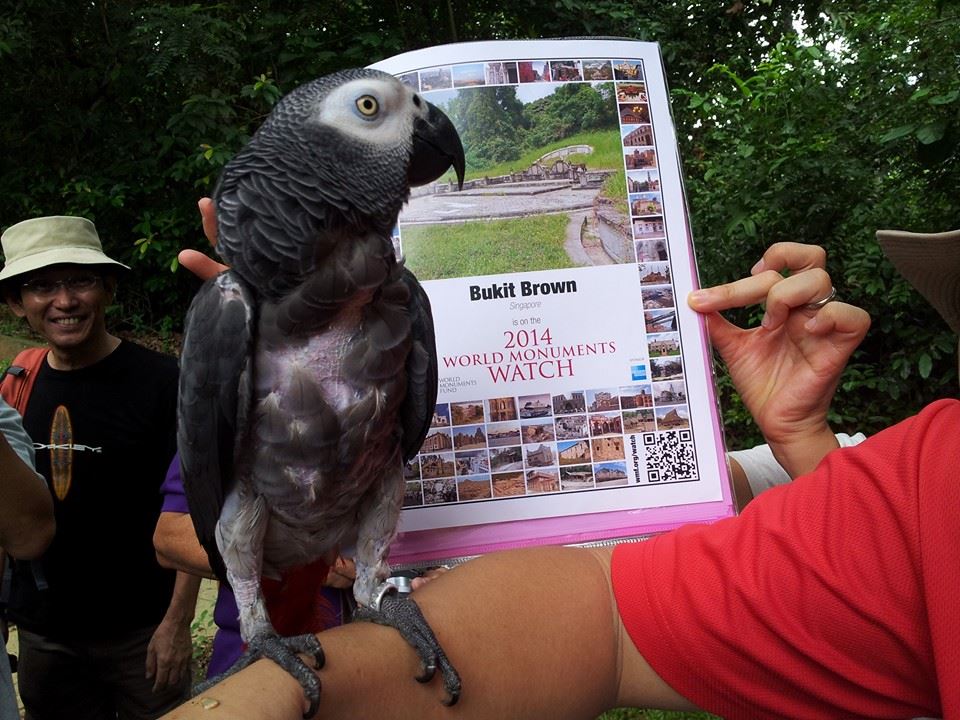
The first tour after the announcement of Bukit Brown’s World Monuments Listing. Basil the macaw weighs in on what it means (photo Khoo Ee Hoon)
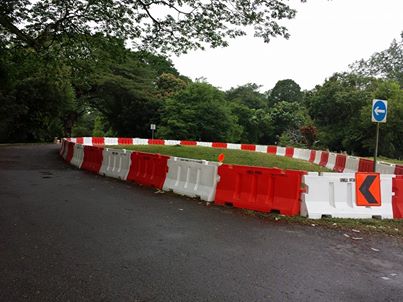
A day after the meet the media session with Brownies on the World Monuments Watch listing, the barricades are up at the roundabout (photo Milli Phuah)
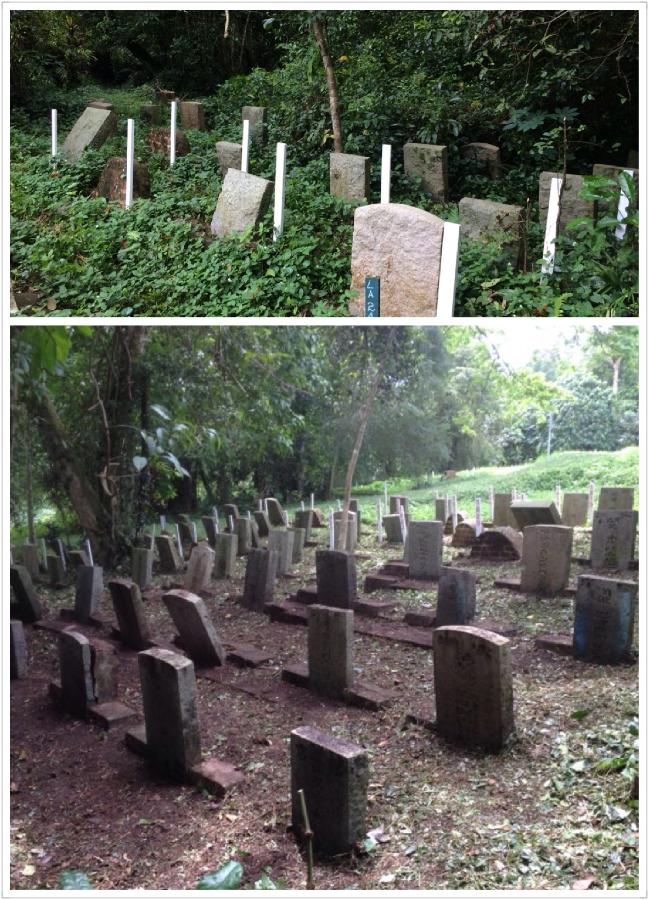


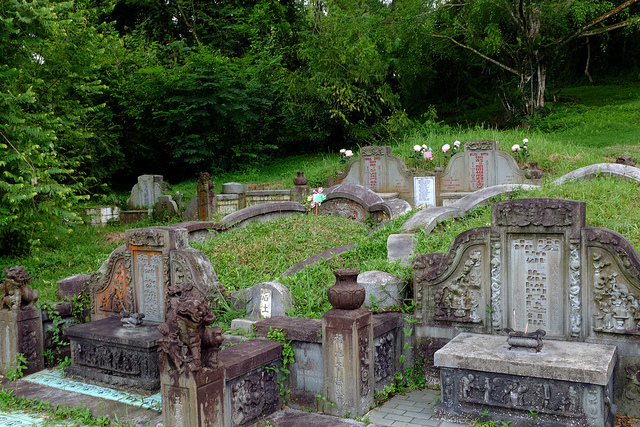
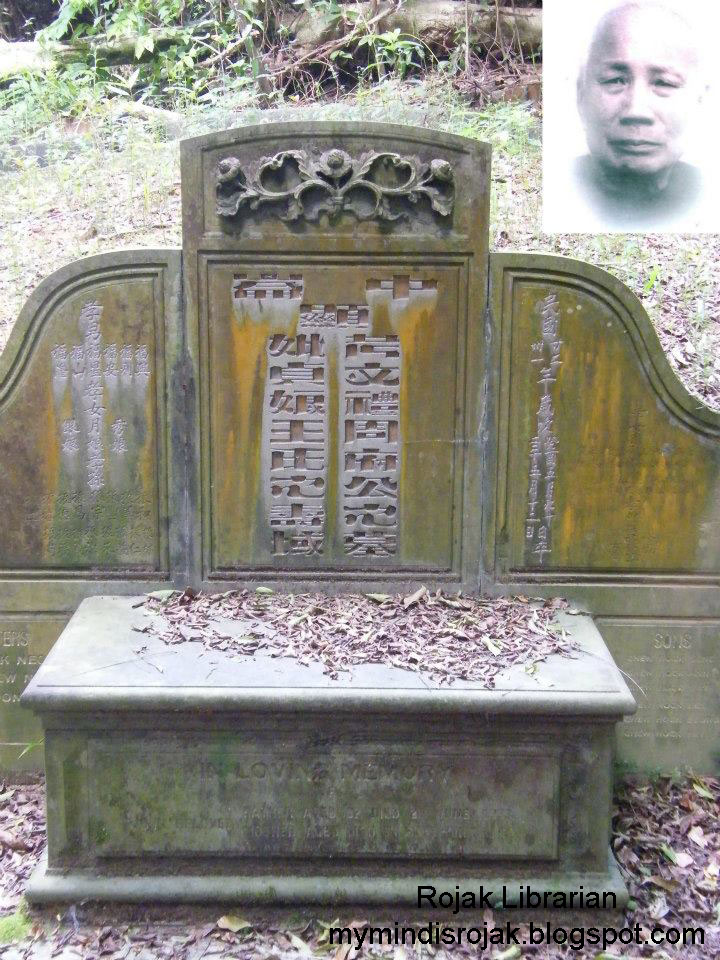


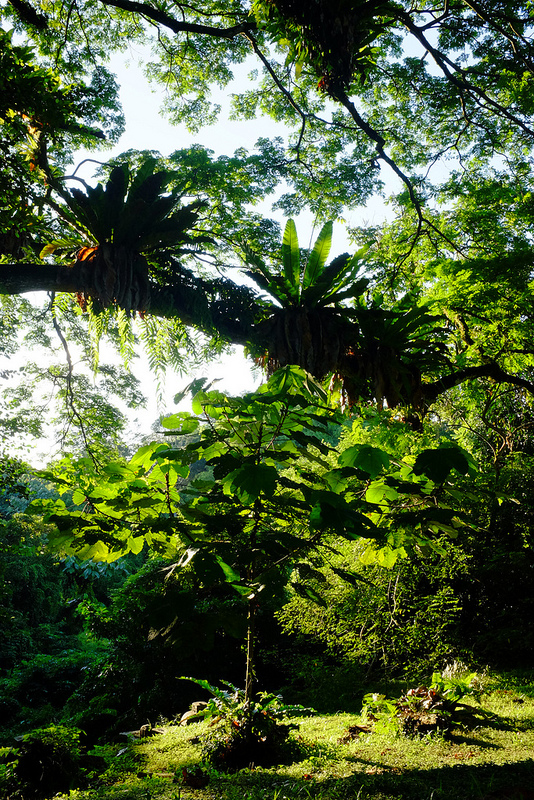
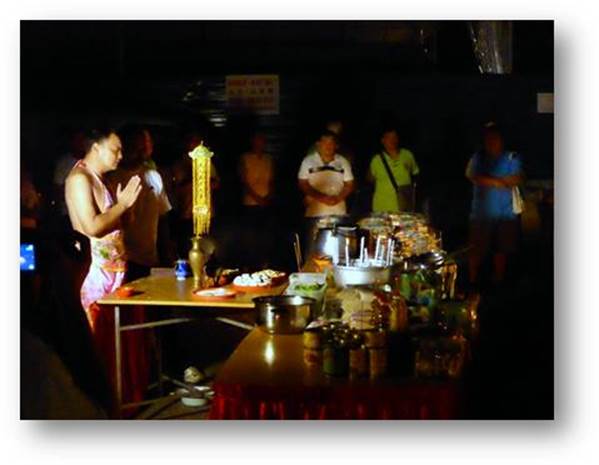
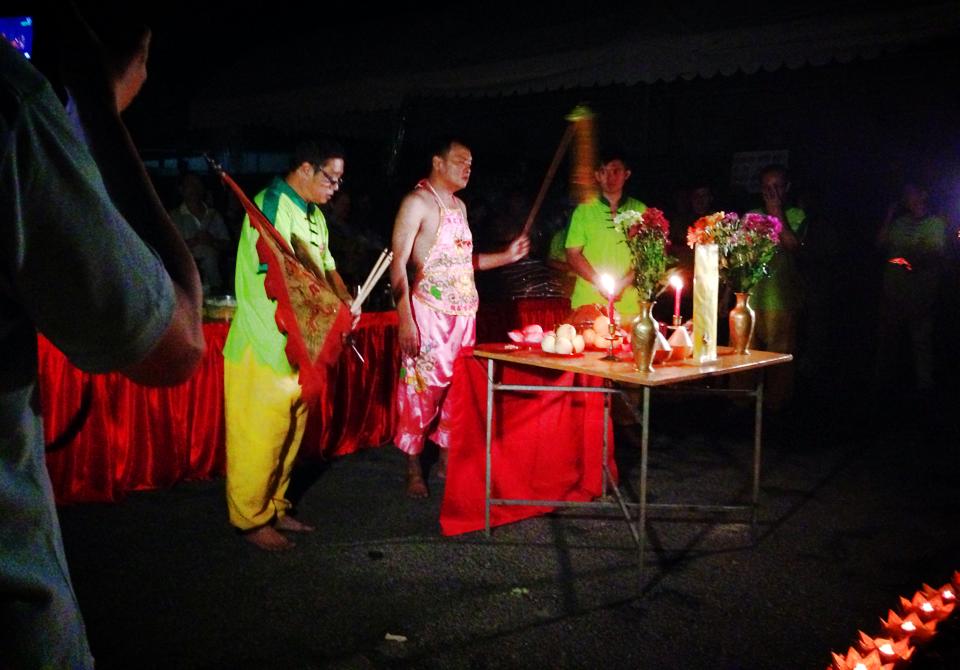
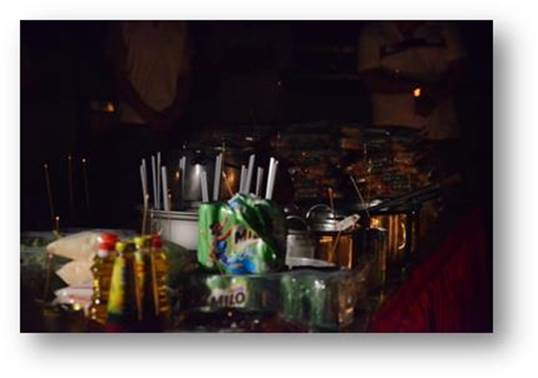

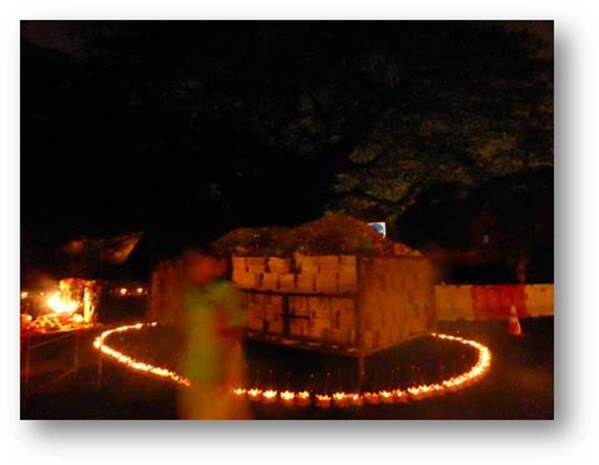
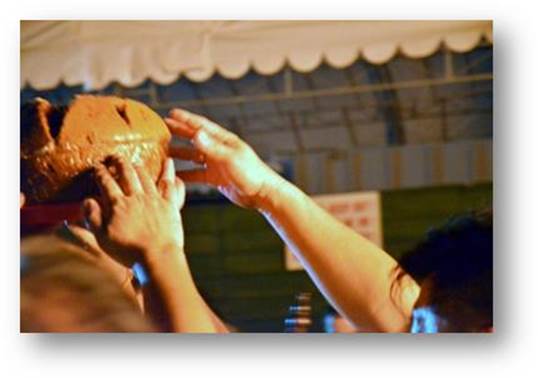
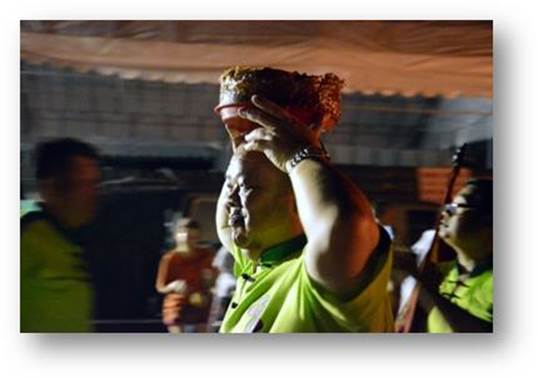
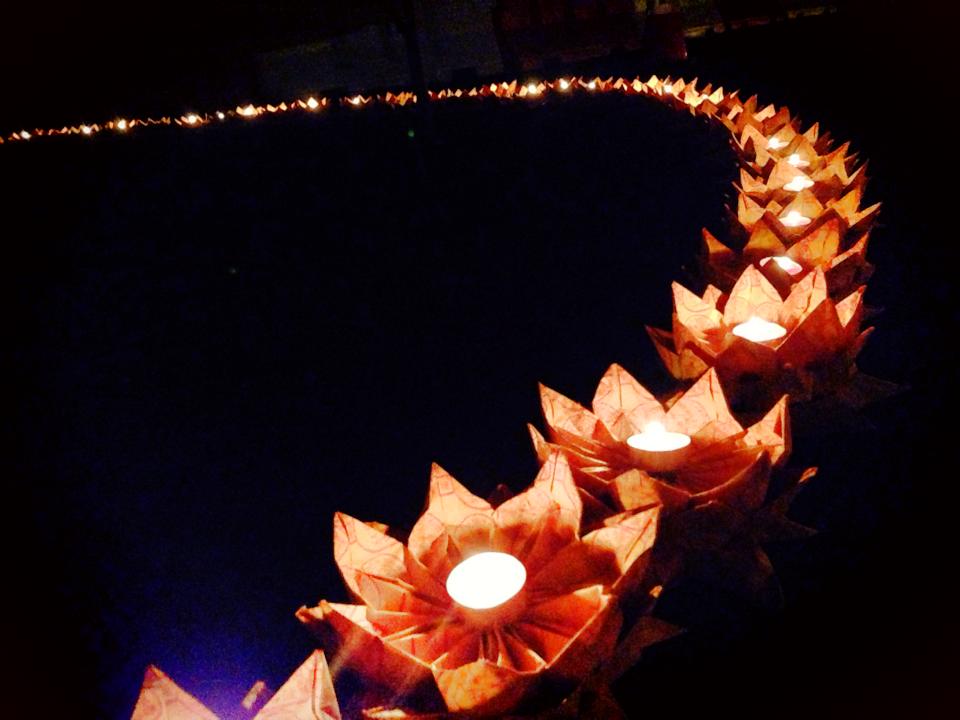

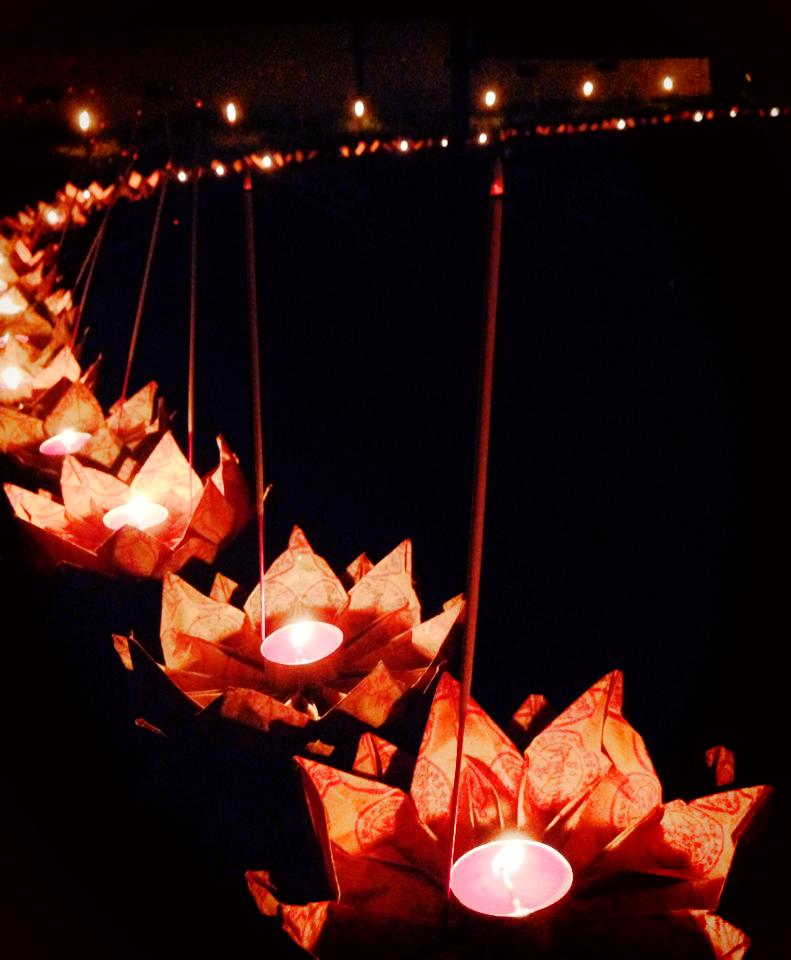
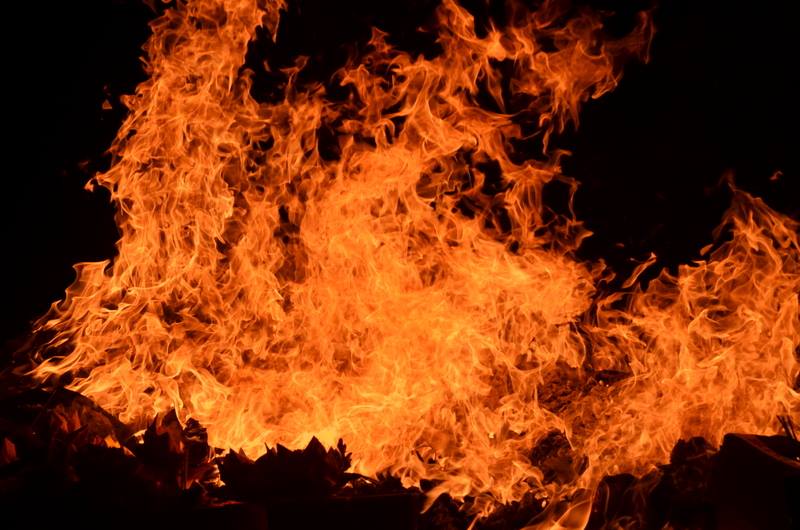
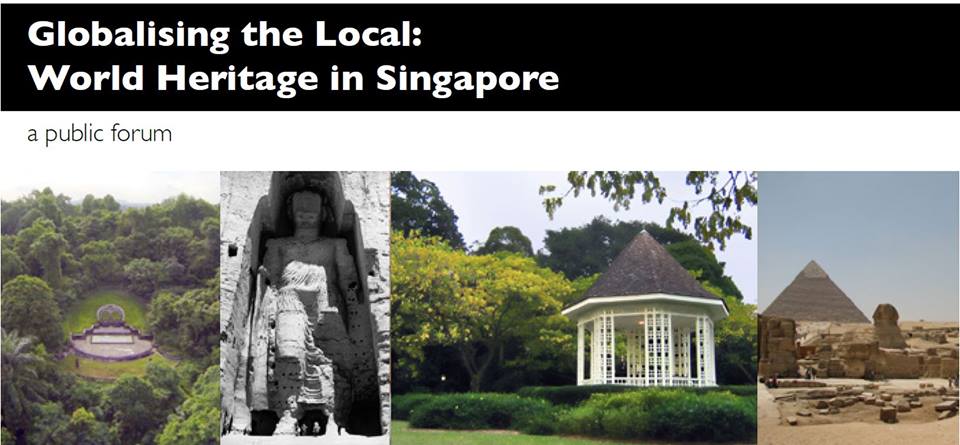
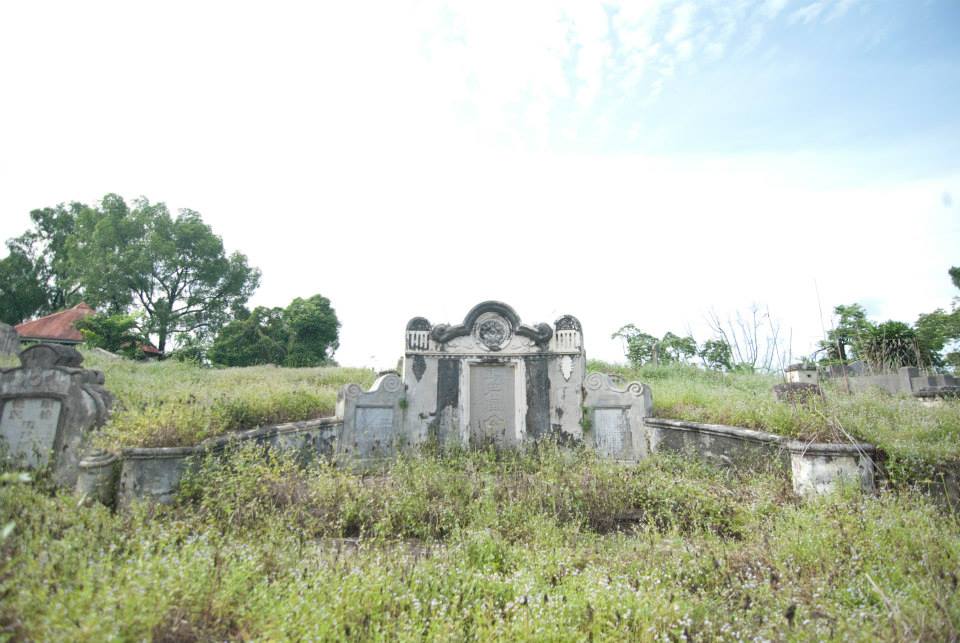

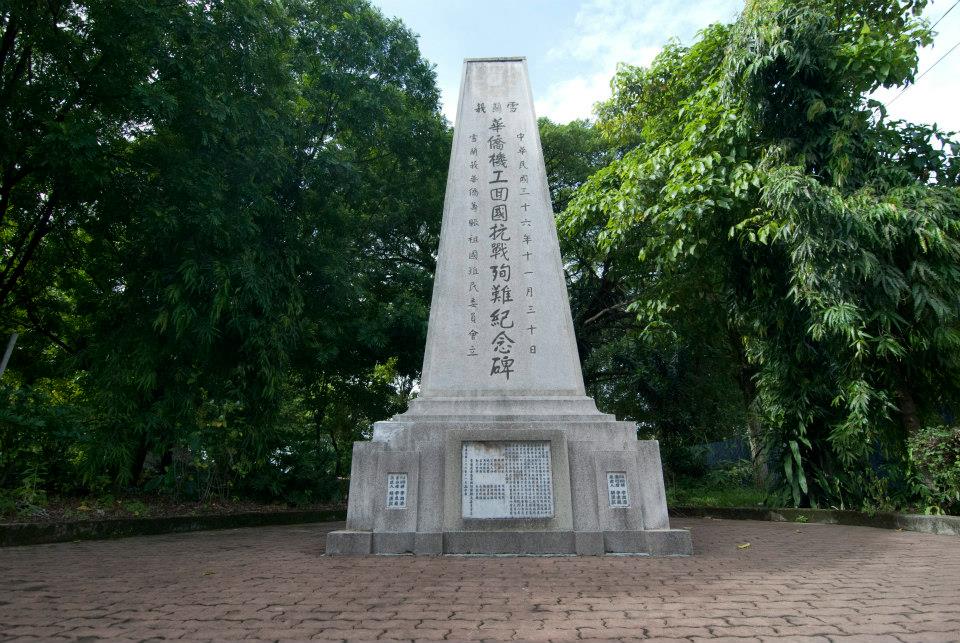
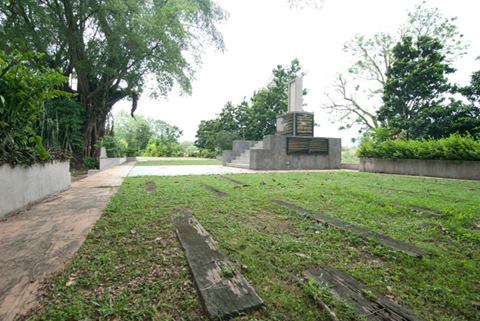
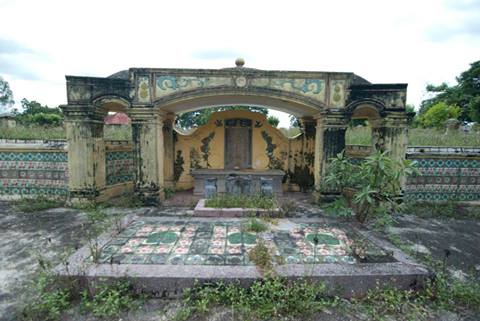
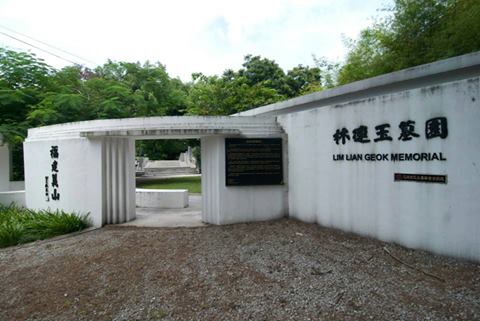


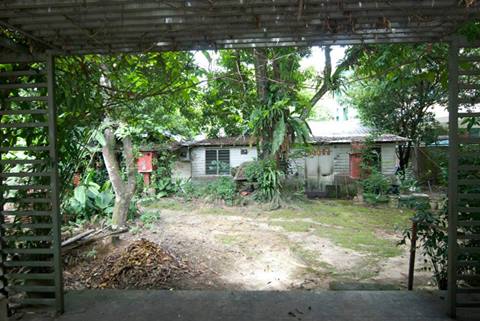
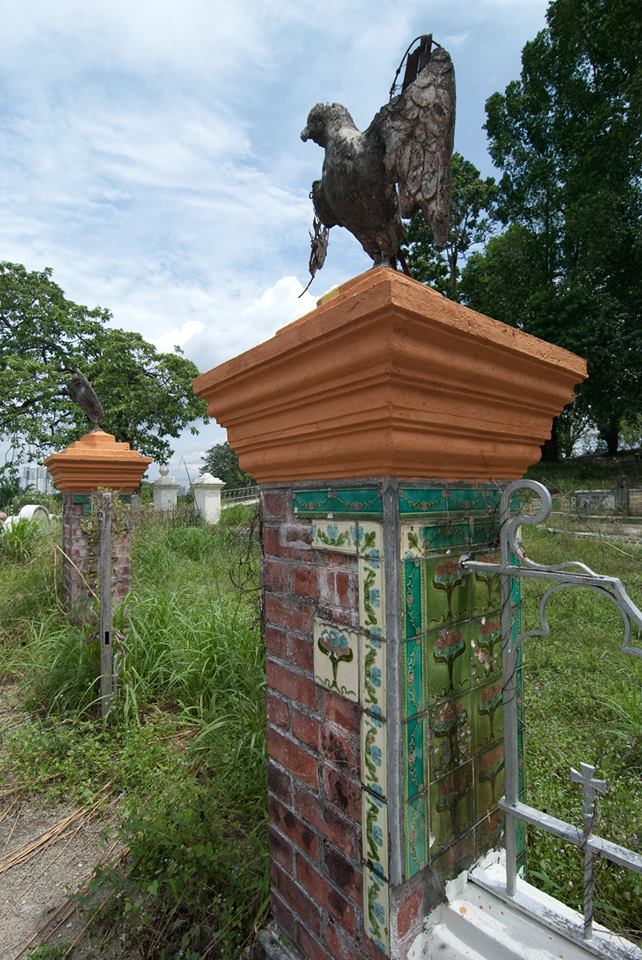


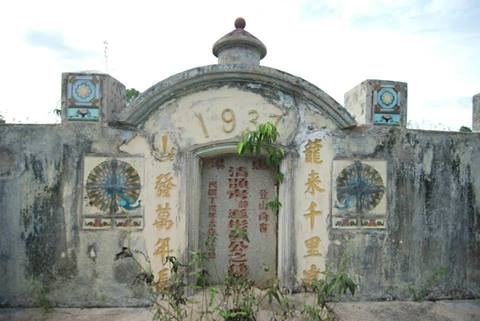

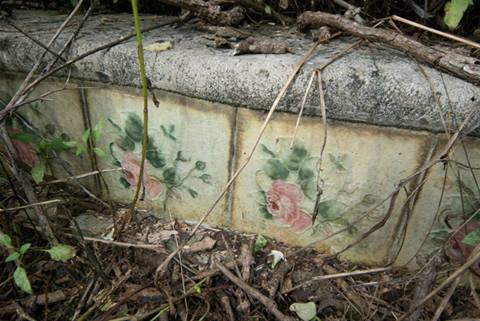








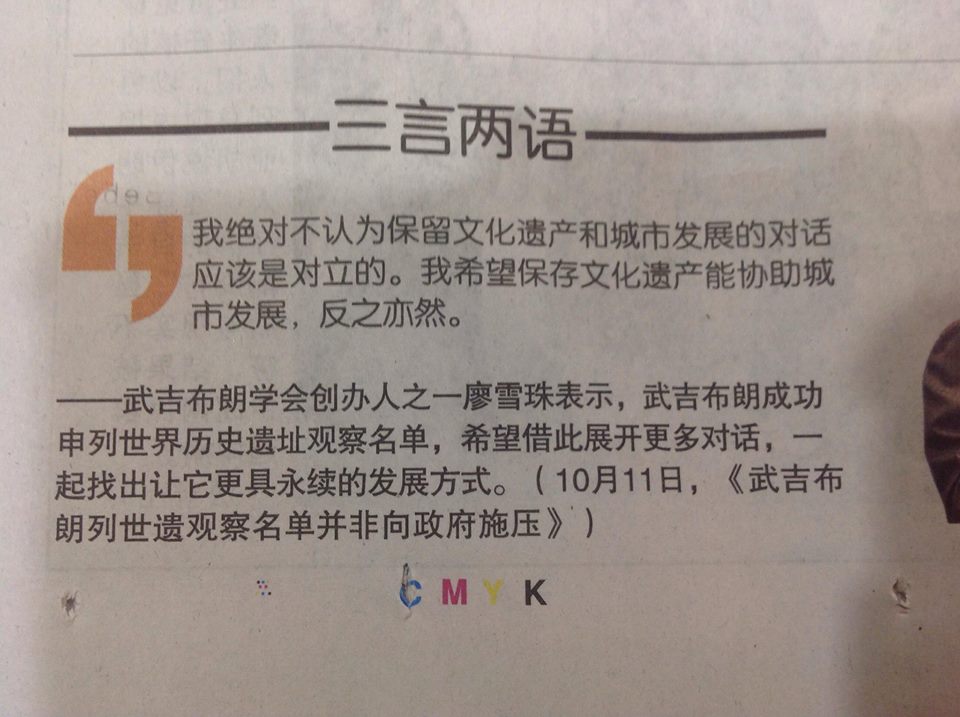

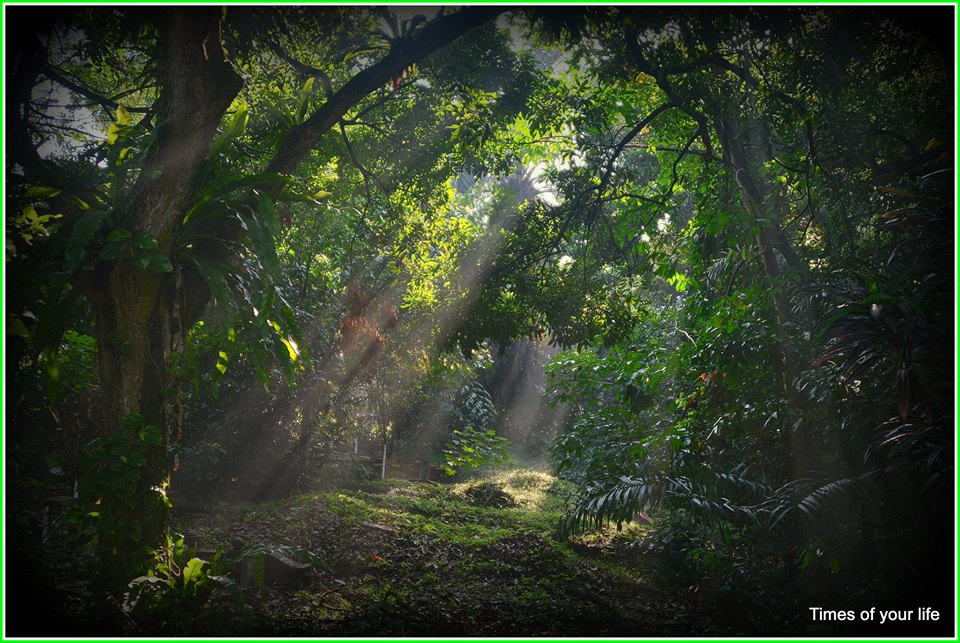

Recent Comments